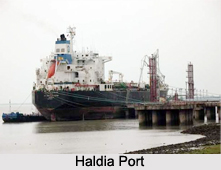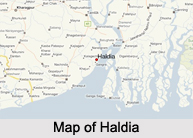 Haldia is a town of Purba Midnapore district, which falls under the jurisdiction of a municipality in the Indian state of West Bengal. Amongst all the people of India, Haldia town is also popular for its huge seaport that is situated near about 50 kms south-western part of Kolkata. It is just built near the mouth of the River Hooghly that is considered to be one of the distributaries of the River Ganges. There is another importance of the Haldia city. The Indian Coast Guard has built their base in the town of Haldia. There is a `hover-port`, which can provide accommodation to two of the six hovercrafts owned by the Indian Coast Guard. Haldia city is highly acclaimed as a main port for trading in Kolkata, which entailed chiefly for huge cargoes.
Haldia is a town of Purba Midnapore district, which falls under the jurisdiction of a municipality in the Indian state of West Bengal. Amongst all the people of India, Haldia town is also popular for its huge seaport that is situated near about 50 kms south-western part of Kolkata. It is just built near the mouth of the River Hooghly that is considered to be one of the distributaries of the River Ganges. There is another importance of the Haldia city. The Indian Coast Guard has built their base in the town of Haldia. There is a `hover-port`, which can provide accommodation to two of the six hovercrafts owned by the Indian Coast Guard. Haldia city is highly acclaimed as a main port for trading in Kolkata, which entailed chiefly for huge cargoes.
Demography of Haldia
According to the census report of 2011, Haldia city had a total population of 200,762. Males comprises of 53 % of the population while female dwellers comprises of 47 %.  Children below the age of 6 years constitutes of 13 % of the population of the city of Haldia. Haldia has an average literacy rate of 89%. Male literacy rate is 79 % and female literacy rate is as high as 98 %.
Children below the age of 6 years constitutes of 13 % of the population of the city of Haldia. Haldia has an average literacy rate of 89%. Male literacy rate is 79 % and female literacy rate is as high as 98 %.
Climate of Haldia
The climate of city of the Haldia is a typical moderate one. During winter season, the temperatures range from 8 to 12 degrees Celsius. Summer seasons are hot, sultry and humid with temperatures rising up to 40 degrees of Celsius. Rainfall is modest, and the rainy months held between the months of May and September.
 Industries in Haldia
Industries in Haldia
In the present day, Haldia has become an icon for industrial development of that state of West Bengal. Various industries, both big and small, have thronged the region over the years. These include South Asian Petrochemicals Limited, Indian Oil Corporation Limited (IOCL), Exide, Shaw Wallace, Tata Chemicals, Petrochemical complex (Haldia Petrochemical) and Hindustan Lever and also a variety of light industries. Haldia Petrochemicals, which has been established in the city and also being the 2nd largest of Indian Territory.
Transportation of Haldia
The entire city of Haldia is being well connected to Kolkata by both bus and train services. Several local transports like taxis and auto rickshaws are also available to reach the Haldia city. Moreover, a catamaran service has started few years back, which carry passengers directly from Kolkata to Haldia.



















